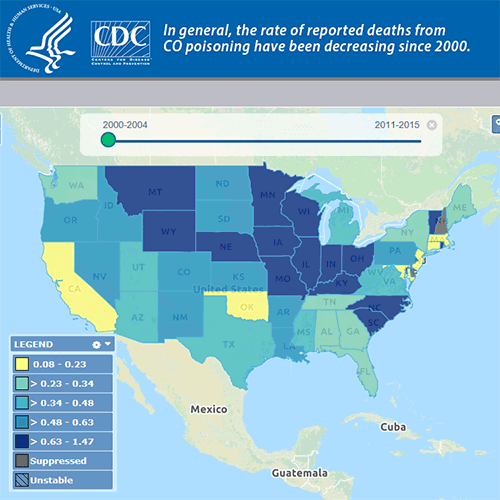Tracking Network Data Spotlight Poisonings
Posted on byCDC’s Environmental Public Health Tracking Network (Tracking Network) connects people with vital public health information. It has data and information that can inform a wide variety of environmental and public health efforts. In recognition of National Poison Prevention Week, we’re highlighting data and information available on the Tracking Network that relate to poisonings. Tracking poisonings in a standard way over time can help us
- Identify high risk groups
- Monitor trends
- Plan effective programs and services to prevent poisonings from happening
- Determine the effects of public health policy aimed at preventing poisonings, and
- Better understand the health consequences of poisonings across the United States.
Carbon Monoxide Poisoning
The Tracking Network provides state-level data about health effects due to carbon monoxide (CO) poisoning including emergency department visits, hospitalizations, and deaths. You can use these data to assess the burden of severe CO poisoning, monitor trends over time, identify high-risk groups, and enhance prevention, education, and evaluation efforts. Learn more about Tracking and CO poisoning.

This animated map of reported CO poisoning deaths is one example of how you can view data on the Tracking Network.
Childhood Lead Poisoning
You can search data on the Tracking Network about blood lead levels among children in two ways: annual blood lead levels and blood lead levels by birth cohort. Annual blood lead level data provide information about the number of children tested each year for blood lead. The other measure shows blood lead levels among children born in the same year, known as a birth cohort. The Tracking Network also provides data on age of housing, which can be used in combination with the blood lead data to help assess testing within areas of potential high risk. Learn more about Tracking and childhood lead poisoning.
Pesticide Exposures
The pesticide exposures data provide information for all 50 states about the rate and number of reported exposures to different kinds of pesticides and the illnesses related to the exposures. In addition, you can select advanced options for the data that provide critical information on the location where people are exposed, such as home or at work; and the reason for the exposure, such as unintentional exposure from air or soil, improper or incorrect use of a pesticide, and work-related activities. Learn more about Tracking and pesticide exposures.
You can read more about illness and injury resulting from exposures to pesticides outside of the workplace in the MMWR Surveillance Summary, Acute Non-occupational pesticide-related illness and injury—United States, 2007-2011.
Poisonings are preventable!
Remember, all kinds of poisonings can be prevented. Check out the following poisoning prevention tips.
- You Can Prevent Carbon Monoxide (CO) Exposure
- Childhood Lead Poisoning Prevention Tips
- Pesticides and Health
- Tips to Prevent Poisonings
Related blog posts
- Carbon Monoxide (CO) Poisoning Prevention
- CDC and AAPCC act fast to track, investigate, and report on outbreaks of poisoning and emerging environmental health threats
Tweet this: “CDC’s Environmental Public Health Tracking Network Data Spotlights Poisonings. Learn more at http://bit.ly/2pe3gLO #CDCEHblog via @CDCEnvironment ”


Post a Comment